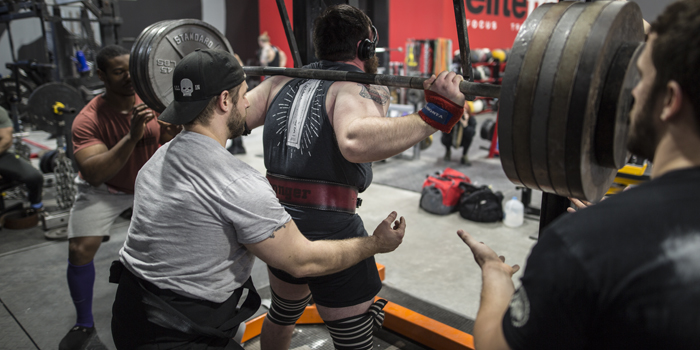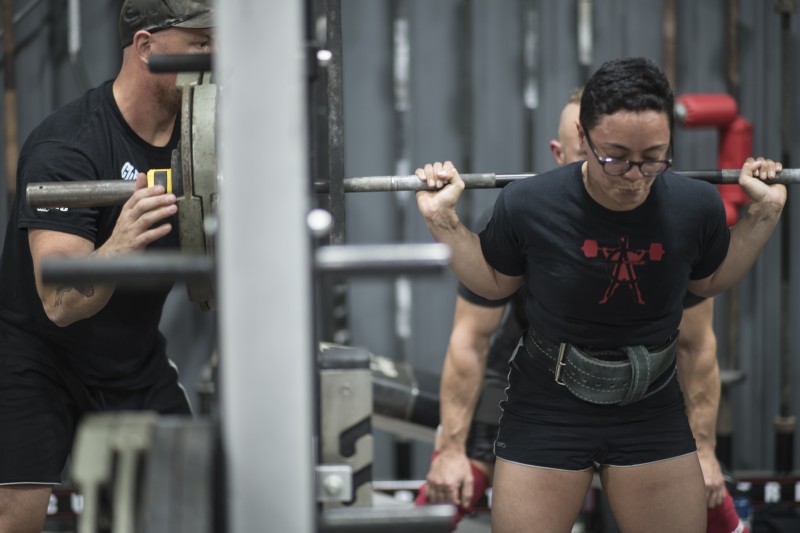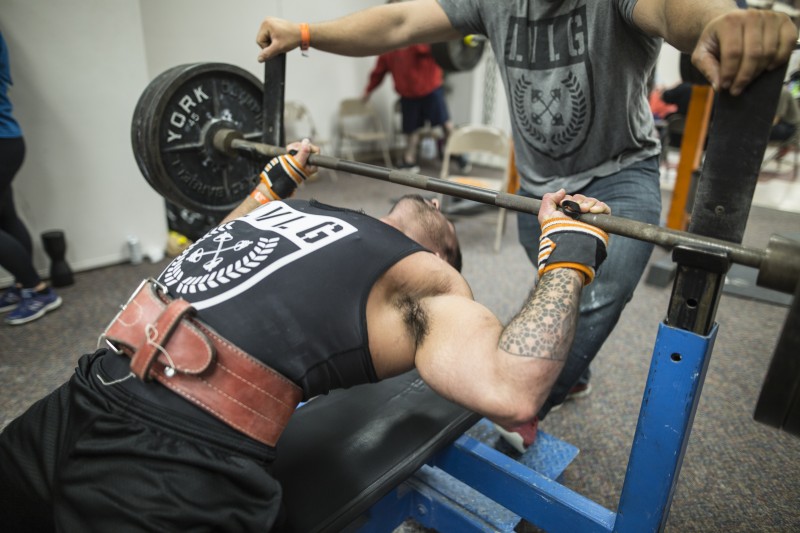
Why should a lifter use the max effort method?
- Enhance capacity to recruit fast-twitch muscle fibers (Bompa, Tudor. Periodization of Strength, 1993)
- Enhance ability to successfully synchronize all muscles involved in the movement (Bompa, 1993)
- Enhance ability to eliminate central nervous system inhibition (Bompa, 1993)
- Enhance maximal concentration and motivation (Bompa, 1993)
- Enhance ability to teach one to strain and think at the same time
- Enhance ability to strain longer
- Enhance ability to recover if lift begins to break form
- Teach lifters how to get tight and "grounded" at the start of the lift
- Avoid getting stale and over-reaching (assuming movements are rotated)
- Increase skill development through segmented development (teaching segments of the lift and then linking back together)
How do I cycle the max effort movements?
You have to always remember that with this style of training, every movement has its own life cycle. In other words, each movement cycles independently of the others. Also, each day cycles independently of the other days. For the max effort day, the first movement (max effort movement) will rotate in a one-week to three-week cycle. There are several ways to accomplish this. The more advanced the lifter, the faster the movement has to change. An advanced lifter will need to change this movement every week. An intermediate will change every two weeks while a beginner will change every three.
How do I know if I'm a beginner, intermediate, or advanced?
If you have to ask this question, you're a beginner. Everyone new to this style of training should treat himself as a beginner. There are checks and balances (C&B's) throughout the program, so you'll know when to change. The C&B's for the max effort movement are if you're breaking records or not. If you chose two-board presses and hit 315 on week one, 320 on week two, and 335 on week three, then you should use a three-week rotation. Now, if you hit 315 on week one, 320 on week two, then can’t do 315 on week three, you should switch every two weeks. The longer you use the method, the sooner you'll be changing every week.
There are a few alternative approaches worth looking into:
- Many coaches have found it best to use a two-week cycle with their athletes, where week one would be an intro week to the movement. Here they may use a percentage-based scheme for a week (such as 70% of their best with the same movement for two sets of five reps, or 80% for three sets of three reps). These coaches have found the athletes do much better on week two (when they hit the one rep) when they use an intro week.
- Another approach similar to the first one is a three-week cycle based on 70% for five reps on week one followed by 80% for three on week two and then 100% of more on week three. I personally don't like this, as I feel the chance of injury is too high with the higher reps when compared to the singles.
- Another approach told to me by a very successful lifter overseas was to cycle the down-sets of the max effort movement. This lifter would work up to a one-rep max and then hit a down-set of a prescribed percentage. He'd use 70% for two sets of five reps on week one, 72% for two sets of five reps on week two, 76% for one set of five reps on week three, and 80% for five reps on week four. The max effort movement would change every week, but the down-set percentage went up for the fourth week. Then the cycle would start again.

Do you do the max effort movement every week?
This answer depends on what you're doing on all the other days, as well as the individual. If you're hitting it very hard with bands on the dynamic day then you may find you can’t hit the max effort movement every week and may have to take it easy one workout of the month. If you find you're not recovering then you'll want to take it easy one of the workouts each month. When you "take it easy" (not a day off) you'll replace the movement with higher rep work using a movement intended to train the same muscles.
How do I know if I went heavy enough?
If you have to ask this question then you're totally missing the boat. This movement is about straining as hard as you can. If you make the weight and have something left then you need to add more weight and go again. When using the max effort method, you must strain to gain!
Different Methods of Max Effort
Multiple Exertion Method
This method involves multiple sets of one or two reps with strict rest periods. Much like the dynamic effort method, this method uses the same load for multiple sets. If you all follow Jim Wendler’s training log you will see he was employing this method in the training of his bench press and deadlift. Jim would work up to 70% to 80% and perform 10 to 15 singles with two minutes rest. This is a great method when you feel you need to get away from weights in the 90% range. While the weight is lighter, it is important to note that when the sets increase, so does the tension. As you get tired, the weights get much harder. That is why this becomes a maximal effort method.
WATCH: Table Talk — Max Effort Work vs. Submaximal Doubles and Triples
You may already be using this method without knowing it. Many people get this method confused with the dynamic effort method. I talk to many people who say they are doing speed deadlifts and then find out they are using 90-second rest periods training with loads between 80% and 90% for singles. When the tempo becomes very slow and the strain very high, you leave the dynamic method and cross over to maximal methods.
Many have found when they use these high exertion methods for their so-called “speed squats” that they are no longer doing dynamic method work but max effort work. When this is the case, there is a very strong need to make alterations to the max effort work you are also doing during the week.
Maximal Concentric Method
This method is just as it sounds: you lift the weight and do not lower it. This is pretty much how most Olympic lifts are completed. As powerlifters, we can also use this method for various movements such as deadlifts, pin pulls, pin presses, Zercher squats, pin squats, suspended squats, suspended good mornings, and suspended bench presses. While your gym owner will hate your guts for doing this, it does have a purpose. The negative phase of the lift is what causes the greatest muscle soreness and damage. If you speak to many lifters, they will tell you that this also is where most injuries happen. By cycling in more maximal concentric movements, you build in a way that allows more recovery.
Let me explain further. Say you have a hard time recovering from max effort training. You may choose to do a four-week phase of max effort work such as:
- Week 1: Board Presses – Work up to 1RM
- Week 2: Close Grip Bench Press — Maximal exertion method
- Week 3: Chain Suspended Lockouts — Concentric only
- Week 4: Rest
With this example, you have one week of partial range eccentrics (board presses), one week of full range eccentric contraction (close grip bench presses), one deload eccentric week (chain suspended lockouts), then one week off. Out of four weeks, you have only stressed the eccentric phase maximally for two weeks (and one of them was a partial range). This will allow for great recovery while still allowing maximal effort training.
You could then add more eccentric loading into the next phase of training. Eccentric loading is very important and should not be taken out of the training for extended periods of time.
Maximal Isometric Method
Okay, I admit it: isometrics suck and have limited value. But I did say “limited” value because that's different than "no value." This means there is value in certain circumstances. Before we get into the method, let's examine when this could be used and why. I strongly feel that a lift is increased by bringing up those muscles that do the work in the lift. I feel you can increase your bench press without benching, your squat without squatting, and your deadlift without deadlifting. This is not how I always felt, but after being around Louie Simmons for so many years, I saw that this is the main factor behind all of his training. The proof is always in the results and I have seen the results. Now with that being said, I would be stupid to not look at all angles when addressing a sticking point. The best way to do this is by using an example.
Lifter A has a bench press of 465 pounds and always gets stuck about five inches off his chest. This would represent the halfway point in his bench press. While it is not my intention to make this a bench press sticking point article, it is important to point out that I feel all sticking points are some combination of mental, physical, and technical problems. We determine that this lifter has a technical problem right at his sticking point. He presses into this position very strong and then stalls. After a split second, he flares his elbows out as he keeps pressing. The bar does not go up, but his elbows flare out.

There are always multiple solutions but one would be to increase the strength of his rotator cuff muscles and lats. This would keep his body position tighter and allow him to push through the sticking point. He should also increase his overall body strength since this has a great effect on all lifts. Finally, he should increase his bar speed going into the sticking point. This will allow him to bust through this barrier.
There is one other thing we could have him do: the maximal isometric method. To do this we would set the pins up in a power rack with one set of pins one inch below his sticking point and one set right off the chest. The lifter would press an empty bar into the top pin and press and hold as hard as he can for three to five seconds (or whatever his average max lift takes). This is a very demanding method that can sneak up to kill you. You need to keep it to only a few sets and no more than once or twice per four-week phase. I would also suggest no more than three pin positions per session.
Here are some other ways to use this method:
- Nine sets with the empty bar for holds from three to five seconds, with 30 seconds rest and performed at the same pin.
- The same as above but using three pin settings for three sets each.
- The same as above but instead of an empty bar, load with 50% of the lifter's one-rep max. You will know the weight is too heavy when you find you are holding the bar against the pins, not pressing it. It is important to press against the pins.
This method will accomplish a couple different things. First, it will develop position-specific strength within a 10 to 15-degree range. This may give him the edge he needs to break through the sticking point. Second, it will allow a “check” for technical positioning during a time of crisis. In other words, he will be able to see what his body does when it strains, and be able to make the required corrections needed to finish the lift. Third—and I feel this could be the most important—is that sticking points are very mental. If you always fail at the same point you will begin to program yourself for this and will not drive past it. You will press into this point knowing you will miss. Without knowing it, you are programming yourself to give up too soon. You may press for a split second and say, “Damn, there it is again.” With the pin press, you will be able to re-program yourself to strain for that extra split second past where you would normally stop. One split second is the difference between a missed lift and a lifetime PR.
Maximal Eccentric Method
I should call this the “high school” method because that is when we used it most. Why? We were all too stupid to know better. You can call it maximal eccentrics, negatives, droppers or whatever you want. The results are still the same: pain, injury, and soreness. The bar is loaded to 130% to 140% of our best one-rep max and then lowered slowly. After it touched our chest, the spotter would pull the bar off us and we would either rack the bar or do another one. ("It’s all you!")
There are valid reasons to do this, but in its purest form, the risk-benefit ratio is too high for the intermediate and advanced lifter. We can get much of the same effect with weight releasers and bands while not having to take the barbell weight up to 140%. The more advanced lifter has a harder time lowering 140% than a beginner.
RELATED: The Max Effort Method vs. Dynamic Effort Method in Group Training
I have seen this work very well for a lifter trying to break in his bench shirt. These sets are doing more than they think. The supported eccentric loading is building the muscles and tendons to handle heavy loads. The shirt helps protect the body from the abuse and is also the reason many lifters complain of sore elbows and forearms with heavy shirt work. The lifters do not feel the effects in the supporting muscles (chest, shoulders, and lats) because of the shirt. I have also seen this work very well with top-down deadlifts. To do this the lifter loads the bar in a rack at the top position. He then stands up with the weight and does an eccentric deadlift to the floor.
Maximal Forced Repetitions
I am sure you all remember forced reps from high school. There are several ways to utilize this method for many different applications. Leaving bodybuilding aside, we will focus on the pure strength aspect. One way to use this method is also one way I do not suggest. I will still include it because there are many others who think this application has great strength training properties. This is a very simple application composed of one or two assisted reps after failure has been reached. Since this is max effort training, you will still need to keep your percentage over 90% and perform one to five reps.
One other way to use forced reps is by using a method many have been using over the past few years. This method has also become known as the "lightened method" or "reverse bands." To use this method you simply hang your barbell from bands so the bands help to lift the weight. This is used on the squat, deadlift, and bench press. Unlike the above application, this method provides help from the beginning of the set. I feel this makes this a much safer method. This is also a great method for those who are looking to increase the middle to endpoints of a lift.
The Maximal Restricted Range Method
This is another one that has been hot for quite awhile. Some examples of this method include:
- Rack presses
- Pin pulls
- Board presses
- High box squats
- Squatting off pins
- Partial leg presses
- Arch back good mornings
- Overhead pin presses
- Pulling off stands
This method allows for maximal overload of very restricted ranges of motion. This method has been very popular over the past 30 years for one reason: it works very well. If you are looking to get strong then you need to include this method in your training.

While I am also not a big proponent of cheating, I do feel there are certain movements where cheating can make a huge difference. One of these includes a chain suspended good morning. This movement is performed by hanging a barbell from strong chains at a mid-waist position. The lifter will then duck under the barbell and arch the bar to the top position. With this movement, the “strain” is the most important thing. Just getting the bar up is more important than if you are doing a good morning or squat. I also feel a slight sink and drive on board presses can do wonders for those who need extra work at the top; it will, however, hurt those who are weak at the middle or lower position, because they are cheating where they need the work. This cheat will allow the weak lockout lifter the opportunity to train with heavier weight. Once again, it is very important to know your weaknesses.
Circa-Maximal Method
This method has many crossover applications. It has been used as a three-week wave in place of straight dynamic method training for some time with great results. While this method can be viewed as dynamic or max effort, it really depends on how it is used. Here are a few examples of the max effort:
- Squats with multiple bands for a one to three-rep max
- Deadlifts against multiple bands for a one-rep max
- Bench press with chains and bands for a one-rep max
The key thing to understand with this method (regardless of application) is to make sure the weight at the top of the movement exceeds 90% of your one-rep max. This is what makes this circa-maximal. The best way to accomplish this while avoiding over-training and acute training injuries is to use chains and/or bands with your barbell weight. There is not a magic percent of weight to bands or weight to chains with this method (this is very different when used as a dynamic method) so all you really need to do is load the bar up to around 50% to 60% barbell weight and add bands or chains.
Here is one example of what I mean for a 500-pound bencher, using the close grip bench press:
- 3 x 45 pounds
- 3 x 45 pounds plus double light band
- 3 x 95 plus double light band
- 3 x 135 plus double light band
- 3 x 185 plus double light band
- 3 x 185 plus double light band plus one chain per side
- Continue adding one chain per side per set and work up to a 1RM
There are several other examples and combinations of how this method can be applied. Don’t be afraid to experiment and see what works best for you.
Maximal Holding Method (Yielding)
This is one that you see from time to time. I am also not a big fan of this one, but it is very popular with a very large number of lifters. This method is great for what I call "strength stabilization." Strength stabilization is how well you can stabilize maximal loads. It really does not mean shit if you can stand on a stability ball if you can’t stabilize maximal weights.
Many of you have heard of (or have done) walkouts for the squat. This is exactly what this method is. Many lifters who do walkouts or stand-ups will set up the weight and hold it for a certain count. This may be three, five, or 10 seconds. I feel the best time would be one to two seconds more than the exact amount of time it takes the lifter to finish a maximal lift with the same lift being trained. For example, if it takes you six seconds to perform a 1RM squat then you will hold your walkout for seven to eight seconds. Remember to keep your body tight!
Here are a few other examples of the maximal holding method:
- High pin deadlift holds
- Very high pin squats
- Very high rack lockouts
- Bench press holds
- Very high board presses
If the exercise has more movement than the setup and hold (very high board presses) then you will do one rep by holding for a couple seconds at the top, lowering and pressing the bar, and then holding for two to three seconds at the top again.











5th Set
M2
Conjugate (not for a while at least)
Have to give each of these a try over the next few years.